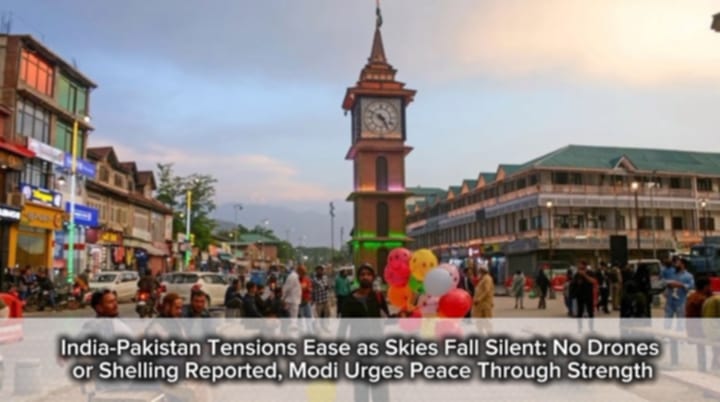May 13, 2025 – After days of heightened alert along the India-Pakistan border following the launch of Operation Sindoor on May 7, the situation appears to be cooling, with Indian Army officials confirming that no enemy drones, firing, or shelling were observed during the night.
The Indian Army described the current environment as “calm and under full control,” signaling a possible de-escalation in tensions that had brought the region to the brink of conflict. Military patrols remain vigilant, but for now, the skies once filled with the hum of surveillance and threat have fallen silent.
Modi Breaks Silence with Firm Warning, Open Door
In his first national address since the launch of Operation Sindoor, Prime Minister Narendra Modi took a resolute yet measured tone, calling on Pakistan to take this moment as an opportunity to reset, while reinforcing India’s hard line on terrorism and cross-border aggression.
“We have made our position very clear,” said BJP leader Dilip Ghosh, speaking on the Prime Minister’s behalf. “Pakistan has been given a chance to improve. But we will not tolerate threats, nor will we bow to nuclear blackmail. India is not afraid.”
Operation Sindoor, a targeted military initiative aimed at dismantling cross-border terror infrastructure, has seen a flurry of drone activity and sporadic skirmishes in recent days. But as of now, Indian authorities say no fresh incursions or provocations have been reported.
From Confrontation to Calculation
The absence of drones and gunfire may suggest that diplomatic backchannels or pressure from international partners is influencing a shift toward caution. However, defense experts warn that tensions remain high and could flare again without substantial political or military restraint from both sides.
“Right now, we’re seeing a tactical pause,” said a retired Army colonel. “But the strategic picture hasn’t changed. Both countries are still watching each other closely, and public sentiment remains charged.”
Standing Firm Against Terrorism
The BJP, currently in full campaign mode ahead of regional elections, is using the crisis to underscore its tough-on-security stance, drawing a sharp contrast with previous governments it accuses of appeasement.
“This is not 2008 or 2016,” Ghosh added. “This is a new India prepared, proactive, and unafraid to defend itself.”
In his address, Modi struck a balance, warning Pakistan against further hostilities while leaving the door open for peace, should Islamabad demonstrate a commitment to ending support for terrorism.
Regional Watch: What Comes Next?
While today’s calm is a welcome reprieve, the path forward remains uncertain. Intelligence agencies are still on high alert, and locals near the border continue to live in fear of renewed escalation.
Diplomatic observers say much now depends on Pakistan’s next move and whether it chooses to de-escalate or retaliate under domestic pressure.
Meanwhile, the Indian government continues to project strength, signaling that any future aggression will be met with force, but not without a final chance for peace.
In Summary:
- No drone activity, firing, or shelling reported overnight on the India-Pakistan border.
- The Indian Army calls the situation “calm and under full control.”
- PM Modi gives Pakistan an opening for peace but vows to stand firm against threats.
- BJP reiterates India will not be intimidated by “nuclear blackmail.”
- Border remains tense, but the silence for now offers a glimmer of restraint.
As both nations weigh their next steps, the world watches hoping that Operation Sindoor will be remembered as a flashpoint turned turning point, rather than a descent into deeper conflict.




